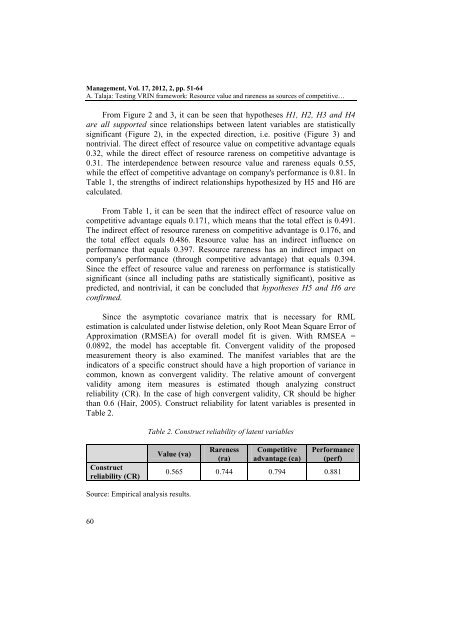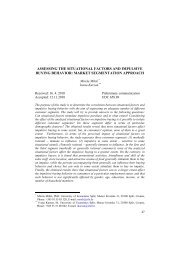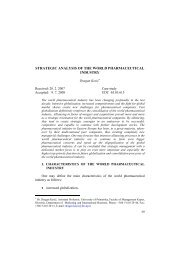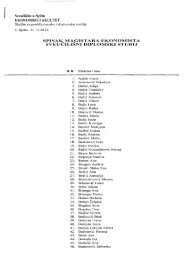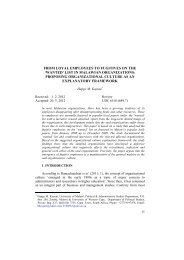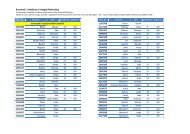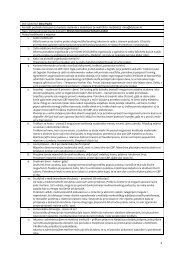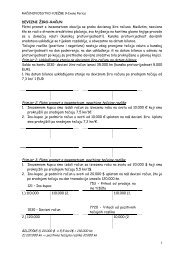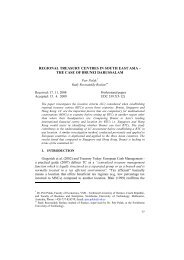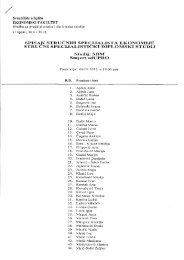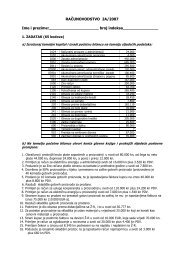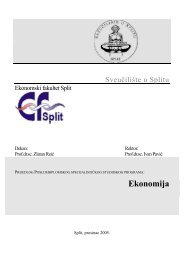Management, Vol. 17, 2012, 2, pp. 51-64A. Talaja: Testing <strong>VRIN</strong> framework: Resource value and rareness as sources of competitive…From Figure 2 and 3, it can be seen that hypotheses H1, H2, H3 and H4are all supported since relationships between latent variables are statisticallysignificant (Figure 2), in the expected direction, i.e. positive (Figure 3) andnontrivial. The direct effect of resource value on competitive advantage equals0.32, while the direct effect of resource rareness on competitive advantage is0.31. The interdependence between resource value and rareness equals 0.55,while the effect of competitive advantage on company's performance is 0.81. InTable 1, the strengths of indirect relationships hypothesized by H5 and H6 arecalculated.From Table 1, it can be seen that the indirect effect of resource value oncompetitive advantage equals 0.171, which means that the total effect is 0.491.The indirect effect of resource rareness on competitive advantage is 0.176, andthe total effect equals 0.486. Resource value has an indirect influence onperformance that equals 0.397. Resource rareness has an indirect impact oncompany's performance (through competitive advantage) that equals 0.394.Since the effect of resource value and rareness on performance is statisticallysignificant (since all including paths are statistically significant), positive aspredicted, and nontrivial, it can be concluded that hypotheses H5 and H6 areconfirmed.Since the asymptotic covariance matrix that is necessary for RMLestimation is calculated under listwise deletion, only Root Mean Square Error ofApproximation (RMSEA) for overall model fit is given. With RMSEA =0.0892, the model has acceptable fit. Convergent validity of the proposedmeasurement theory is also examined. The manifest variables that are theindicators of a specific construct should have a high proportion of variance incommon, known as convergent validity. The relative amount of convergentvalidity among item measures is estimated though analyzing constructreliability (CR). In the case of high convergent validity, CR should be higherthan 0.6 (Hair, 2005). Construct reliability for latent variables is presented inTable 2.Table 2. Construct reliability of latent variablesConstructreliability (CR)Value (va)Rareness(ra)Competitiveadvantage (ca)Performance(perf)0.565 0.744 0.794 0.881Source: Empirical analysis results.60
Management, Vol. 17, 2012, 2, pp. 51-64A. Talaja: Testing <strong>VRIN</strong> framework: Resource value and rareness as sources of competitive…From Table 2, it can be seen that construct reliability (CR) for resourcerareness, competitive advantage and performance is acceptable, i.e. higher than0.6, while CR for resource value is slightly under 0.6 (CR=0.565).5. CONCLUSIONThis study provides an empirical test of main resource-based viewpropositions. The results show that valuable and rare resources significantlyaffect company's competitive advantage and performance. The model is testedusing sample of 265 large and medium Croatian companies from all industries.The results of structural equation modeling show that all paths are significantand in the expected direction, which means that all hypotheses proposed by themodel are confirmed. The convergent validity of a proposed measurementtheory is also confirmed and the overall model fit is acceptable. These findingshave implications for resource-based view and strategic management theory andresearch, as well as for the management profession.<strong>VRIN</strong> framework, as one of the basic concepts from the resource–basedview, although much mentioned in the strategic management literature, is notenough empirically tested. The hypotheses that link valuable, rare, inimitableand non-substitutable resources and capabilities to company’s competitiveadvantage are purely theoretical. This study tests some of the <strong>VRIN</strong> hypothesesat the conceptual level, and provides evidence that valuable and rare resourcesand capabilities can help company in achieving competitive advantage andabove average performance. It also models and empirically confirms theinterdependence between the two main resource characteristics, value andrareness. By empirically confirming one of the basic hypotheses from <strong>VRIN</strong>framework, this study significantly contributes to the resource-based view. Inaddition, by confirming the importance of company’s physical, human,organizational, intellectual and financial resources for company’s success, thisstudy makes a contribution to strategic management theory by emphasizing theimportance of company’s internal environment and its influence on company’sability to compete on different markets.Possible implications for the management profession include emphasizingthe importance of not only developing and accumulating different types ofresources, i.e. physical, human, organizational, intellectual and financial, butalso having capabilities for using them. Companies ought to give particularattention to characteristics of their asset in order to enhance their competitiveadvantage and develop strategies based on their resources and capabilities. Thatmeans that they should accumulate and develop resources and capabilities that61
- Page 1 and 2: TESTING VRIN FRAMEWORK: RESOURCE VA
- Page 3 and 4: Management, Vol. 17, 2012, 2, pp. 5
- Page 5 and 6: Management, Vol. 17, 2012, 2, pp. 5
- Page 7 and 8: Management, Vol. 17, 2012, 2, pp. 5
- Page 9: Management, Vol. 17, 2012, 2, pp. 5
- Page 13 and 14: Management, Vol. 17, 2012, 2, pp. 5


